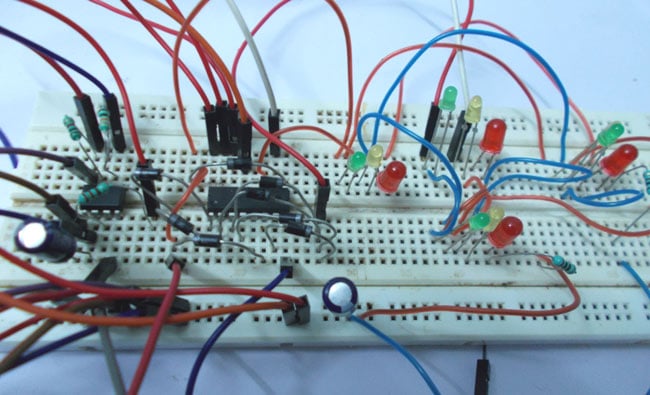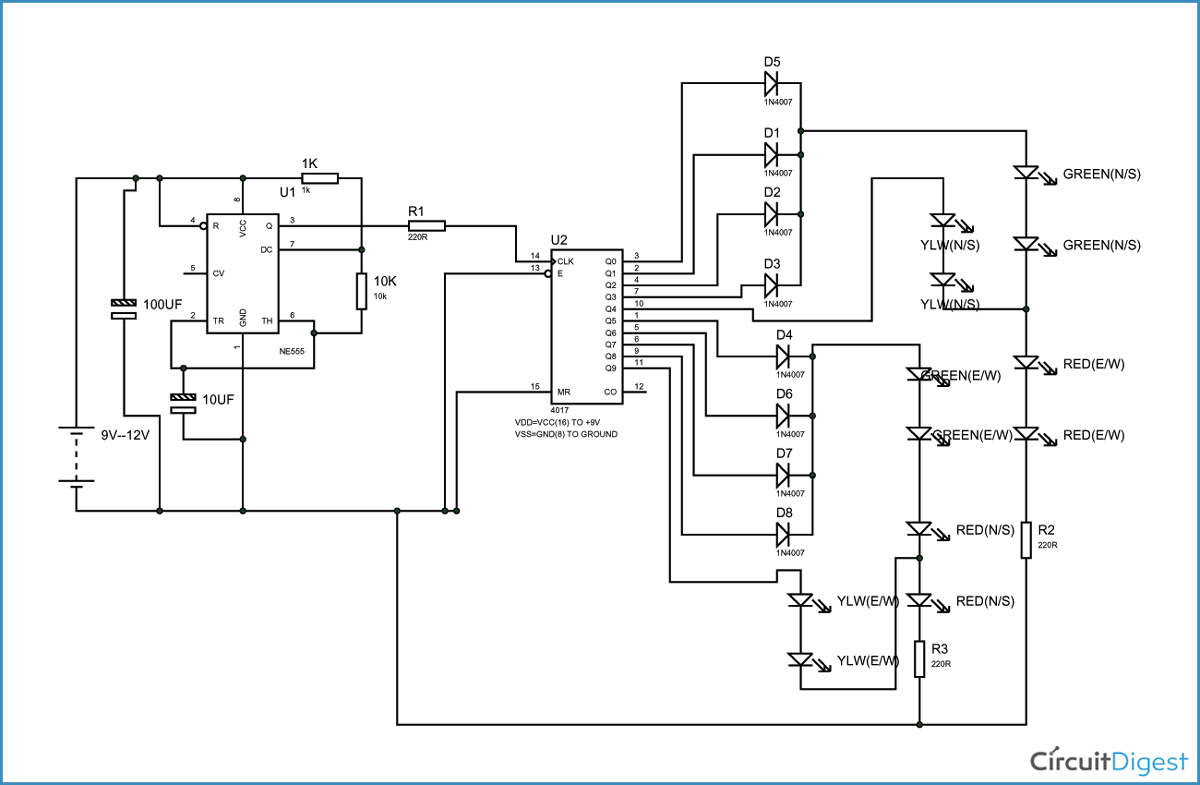
In this traffic light project we are going to design a circuit, to control traffic lights on a four-way signal. This circuit is designed by 555 Timer IC and a decade counter. The timer generates pulses and these pulses are fed to the ten stage decade counter.
The ten stage DECADE COUNTER have a memory of TEN. It can count up to ten pulses. So for every peak at clock, the counter admits it as an event and remembers it. The number of events that counter memorized outputted by corresponding pin.
Circuit Components
- +9v to +12v supply voltage
- 555 Timer IC
- 1KΩ, 10KΩ, 220Ω resistors (3 pieces),
- 10µF and 100µF capacitors
- RED LED (4 pieces), BLUE LED (4 pieces) and YELLOW LED (4 pieces)
- CD4017 Decade Counter IC
- IN4007 diodes (8 pieces)
Four Way Traffic Light Circuit Diagram and Explanation
Four way traffic light circuit diagram using 555 Timer IC is shown in the above diagram. The timer here generates pulses of time period 100ms approximately. So the ON time is 50ms and OFF time is 50ms. This time duration can be changed by changing the capacitor value. Although street lights have a shift time for 2minutes, here we are reducing the time for testing the circuit.
The time shift for a four way traffic light can be achieved in this circuit by replacing the 10uF capacitor with a 470uF one. Once the power is tune ON, the timer acts as a square wave generator and generates clock, this clock is fed to the DECADE BINARY COUNTER. Now the decade binary counter counts the number of pulses given at the clock and lets the corresponding pin output go high, for example, if the event count is 3 then Q2 pin of counter will be high and if 5 is count the pin Q4 will be high. So for every 100ms there will be a peak, with this peak the counter memory gains by one and so is the output.
The diodes here prevent the shorting of counter outputs, say if the count is two with this the Q1 will be high (since Q1 is high all other outputs will be low including Q0, Q2) in the absence of diodes, Q1 with positive voltage gets hardly pulled down to LOW by Q0 (as Q0 voltage be +0V when Q1 is high), as they are connected together. With this short circuit takes place.
So during Q0, Q1, Q2, Q3 high the GREEN LED on NORTH and SOUTH will be ON along with RED LED on EAST and WEST. So if we assume clock is of 1Hz, the NORTH and SOUTH side are signaled GREEN to go for four sec and also the EAST and WEST side are signaled RED to STOP during this time.
When Q4 goes high, the YELLOW LED on NORTH and SOUTH will be ON along with RED LED on EAST and WEST. So if we assume clock is of 1Hz, the NORTH and SOUTH side are signaled YELLOW to slow down for 1sec and also the EAST and WEST side are signaled RED to STOP during this time.
When Q5, Q6, Q7, Q7 high the GREEN LED on EAST and WEST will be ON along with RED LED on NORTH and SOUTH. So if we assume clock is of 1Hz, the EAST and WEST side are signaled GREEN to go for four sec and also the NORTH and SOUTH side are signaled RED to STOP during this time.
When Q4 goes high, the YELLOW LED on EAST and WEST will be ON along with RED LED on NORTH and SOUTH. So if we assume clock is of 1Hz, the EAST and WEST side are signaled YELLOW to slow down for 1sec and also the NORTH and SOUTH side are signaled RED to STOP during this time.
These above four stages form a continuous cycle, to control the traffic light on a four way.
[Also check: Arduino Traffic Light Controller Project]







did the simulation run perfect in proteus? i tried it but the LED are not working